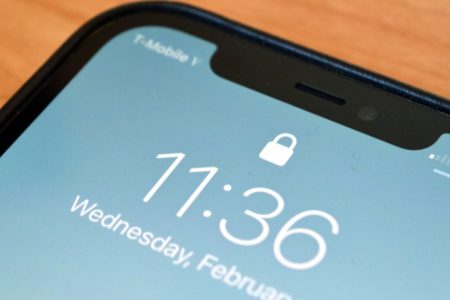
Apple is famous for the sleek, minimal design of its products, but sometimes functionality has to trump minimalism. That’s been the case with the iPhone’s Face ID system, which provides a very convenient and hands-free way to unlock your phone just by looking at it, but which requires a pill-shaped cutout at the top of the screen to work.
Now, though, it’s looking like Apple may ditch the cutout but keep the Face ID unlock option by using detectors placed beneath the screen instead. This under-screen Face ID option would mean that only a small cutout would be required in one corner of the screen for the front-facing camera, so the pill cutout could be removed.
The latest info comes from Ross Young, VP at Counterpoint Research, who wrote on X about an announcement at the Society for Information Display conference this week:
“At the SID Business Conference today, OTI Lumionics CEO Michael Helander confirmed that they expect phones with under panel Face ID using their materials to be available for sale in 2026,” Young wrote. “This suggests that iPhone 18 Pro models will have under panel Face ID with other brands and models to follow…”
Rumors about the switch to under-screen Face ID have been growing in recent weeks, with previous info on the iPhone 18 Pro also suggesting that this could be the case. However, it would be a technical challenge for Apple to pull this off, as a front-facing camera can easily create a 3D map of someone’s face using infrared dots, but this is much harder to do when the infrared signals have to pass through a OLED panel with high pixel density like that used on iPhones.
Apple did secure a patent last year for the placement of cameras behind an active display, suggesting that the company has been working on this change for some time. However, due to the significant amount of redesign work this would necessitate, it won’t be seen in the upcoming iPhone 17 series which is set to be released later this year. Instead, it is most likely to be a part of the plans for the iPhone 18 series, which is expected to be released in 2026.

Georgina has been the space writer at Digital Trends space writer for six years, covering human space exploration, planetary…
There may not be an iPhone in 10 years’ time, says top Apple exec

Well, whouda thunk it. A top Apple executive positing the idea that in 10 years from now, the iPhone — your beloved iPhone (unless you have a beloved Android phone, that is) — may no longer exist.
Before your head explodes at the mere thought of Apple abandoning the iPhone in 10 years’ time, there’s also a chance that in 2035 there will be an iPhone 27, or whatever’s Apple’s calling it by then.
Read more
iPhone 17 Air: everything you need to know
The iPhone 17 Air is set to become the first iPhone that’s as light as a feather — or light as air, as its name suggests. Not because it’s as tiny as the oldest iPhone models, but rather it’s because it’s as thin as the MacBook Air that inspired it and thinner than the rest of the iPhone 17 line.
Although the iPhone 17 Air is months away from being officially announced by Apple, let alone the standard iPhone 17, the leaks and rumors swirling around the ultra-slim model have iPhone users excited about the prospect of holding it in their hands and anxious about its fragility because of its thinness. Here’s everything you need to know about the iPhone 17 Air.
Read more
The iPhone 18 Pro could see a major design change
If the iPhone 18 release schedule wasn’t enough of a shift, it looks like the iPhone 18 Pro and Pro Max models could switch to under-screen Face ID and have only a small camera in the top-left corner of the screen. The news comes from Digital Chat Station on Weibo, a leaker with an inside hook into Apple’s supply chain.
“Well, I checked with the Apple supply chain a few days ago. The iPhone 18/18 Pro Max is indeed testing 3D faces under the screen, with a single HIAA hole; the iPhone 8/18 Air is a regular 2+1 hole,” they write (as translated by Google.)
Read more
